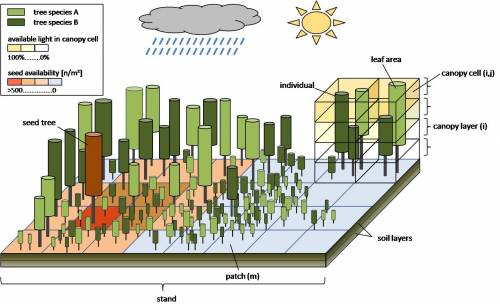This is an old revision of the document!
Table of Contents
The Ecosystem Model PICUS
 PICUS is a hybrid forest gap model combining a 3D gap model approach with the physiologically-based production approach 3PG. The model simulates individual tree dynamics on 10×10m patches and structure tree crowns within 5m cells. It accounts for spatially explicit interactions between patches via a 3D light module, simulates explicit seed dispersal as well as ecosystem carbon, nitrogen and water cycles. The model includes a submodel of bark beetle disturbances in Norway spruce and a management module allowing any silvicultural treatment to be mimicked realistically. PICUS has been successfully evaluated in simulating equilibrium species composition as well as in reproducing longterm stand development in growth and yield experimental plots. The model has recently been successfully applied to support climate change adaptation planning.
PICUS is a hybrid forest gap model combining a 3D gap model approach with the physiologically-based production approach 3PG. The model simulates individual tree dynamics on 10×10m patches and structure tree crowns within 5m cells. It accounts for spatially explicit interactions between patches via a 3D light module, simulates explicit seed dispersal as well as ecosystem carbon, nitrogen and water cycles. The model includes a submodel of bark beetle disturbances in Norway spruce and a management module allowing any silvicultural treatment to be mimicked realistically. PICUS has been successfully evaluated in simulating equilibrium species composition as well as in reproducing longterm stand development in growth and yield experimental plots. The model has recently been successfully applied to support climate change adaptation planning.
Applications and Literature
- Model evaluation and model comparison (Badeck et al. 2001, Price et al. 2001, Keane et al. 2001, Seidl et al. 2005a)
- Simulation of the potential natural vegetation for Austria’s forests (Lexer 2001, Lexer and Hönninger 2001)
- The sensitivity of Austrian forests to climate change (Lexer et al. 2001, Lexer et al. 2002)
- Simulation of the effects of ecosystem restoration measures (Jäger et al. 2000)
- Assess the impact of abrupt climate change on mountain forests (Seidl 2004b)
- Long-term simulation of the late-glacial and holocene forest succession in the Eastern Alps (Jäger 2005)
- Simulation of well-structured multi-species forests under a target diameter harvest regime (Seidl 2004b, Seidl et al. 2005a)
- Implications of bark beetle infestations on timber production and carbon sequestration under climate change (Seidl et al. 2005b)
- Analysis of management strategies with regard to sustainable multi-purpose forestry considering climate change and carbon sequestration (IFORCAM-Projekt of the BMLFUW)
- Integrated Carbon sink enhancement assessment (EU-FP6 project INSEA http://www.iiasa.ac.at/Research/FOR/INSEA/index.html)
- Assessing silvicultural response strategies to climatic change in management of European forests (EU-project “Silvistrat”) (Kellomäki and Leinonen 2005)
- Assessment of forest management strategies with regard to rockfall protection (Woltjer 2005)
- Integration of forest ecosystem models into a multi-criteria decision framework with regard to sustainable forest management (Wolfslehner et al. 2005)
Team
 The development of the PICUS model was started more than 10 years ago by M.J. Lexer at BOKU Vienna. Over time, valuable contributions were made by researchers, PhD students and software engineers such as Karl Hönninger, Dietmar Jäger, Werner Rammer, Rupert Seidl, Stefan Schörghuber, Michael Maroschek, Andreas Schimmel and others.
The development of the PICUS model was started more than 10 years ago by M.J. Lexer at BOKU Vienna. Over time, valuable contributions were made by researchers, PhD students and software engineers such as Karl Hönninger, Dietmar Jäger, Werner Rammer, Rupert Seidl, Stefan Schörghuber, Michael Maroschek, Andreas Schimmel and others.
PICUS is currently applied at the Institute of Silviculture, BOKU Vienna and the Institute of Forest Ecology, ETH Zürich - if you’re interested in the program package please contact Manfred J. Lexer (email: mj.lexer(at)boku.ac.at).
